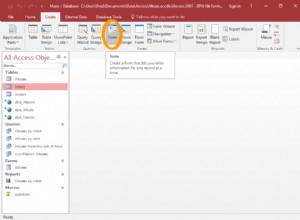siehe Beispiel unten
SELECT mydate calendar_date
,EXTRACT(WEEK FROM mydate) week_num
,EXTRACT(month FROM mydate) month_num
,to_char(mydate,'Mon') month_name
,EXTRACT(Quarter FROM mydate) quarter_num
,EXTRACT(year FROM mydate) calendar_year
,EXTRACT(DOW FROM mydate) iso_dayofweek
,to_char(mydate, 'day') dayofweek_name
FROM (
SELECT now()::DATE mydate
) t
Ergebnis:
calendar_date week_num month_num month_name quarter_num calendar_year iso_dayofweek dayofweek_name
------------- -------- --------- ---------- ----------- ------------- ------------- --------------
2015/04/24 17 4 Apr 2 2015 5 friday
Sie können generate_series() verwenden um alle Daten in einem Jahr zu erhalten, zum Beispiel:2015
select generate_series(0,364) + date'1/1/2015'
dies ergibt ein Datum von 1/1/2015 - 31/12/2015 , und verwenden Sie diese Auswahl statt SELECT now()::DATE im gegebenen Beispiel
Wenn Sie eine Tabelle für das Jahr 2015 erstellen möchten dann können Sie die folgende Abfrage verwenden
CREATE TABLE mycal_2015 AS
SELECT row_number() OVER () date_key
,mydate calendar_date
,EXTRACT(WEEK FROM mydate) week_num
,EXTRACT(month FROM mydate) month_num
,to_char(mydate,'Mon') month_name
,EXTRACT(Quarter FROM mydate) quarter_num
,EXTRACT(year FROM mydate) calendar_year
,EXTRACT(DOW FROM mydate) iso_dayofweek
,to_char(mydate, 'day') dayofweek_name
FROM (
SELECT generate_series(0, 364) + DATE '1/1/2015' mydate
) t
und die Tabelle sieht aus wie select * from mycal_2015
date_key calendar_date week_num month_num month_name quarter_num calendar_year iso_dayofweek dayofweek_name
-------- ------------- -------- --------- ---------- ----------- ------------- ------------- --------------
1 2015/01/01 1 1 Jan 1 2015 4 thursday
2 2015/01/02 1 1 Jan 1 2015 5 friday
3 2015/01/03 1 1 Jan 1 2015 6 saturday
4 2015/01/04 1 1 Jan 1 2015 0 sunday
5 2015/01/05 2 1 Jan 1 2015 1 monday
6 2015/01/06 2 1 Jan 1 2015 2 tuesday
...
.
.
.
364 2015/12/30 53 12 Dec 4 2015 3 wednesday
365 2015/12/31 53 12 Dec 4 2015 4 thursday
POSTGRESQL:EXTRAHIERFUNKTION
Die PostgreSQL-Extraktionsfunktion extrahiert Teile aus einem Datum
Syntax:extract( unit from date )
date ist ein Datums-, Zeitstempel-, Zeit- oder Intervallwert, aus dem der Datumsteil extrahiert werden soll.
Einheit ist der Einheitentyp des Intervalls, z. B. Tag, Monat, Minute, Stunde usw.
Dies kann einer der folgenden sein:
unit description
--------------- -----------------------------------------------------------------------------------------------------------------------------
century Uses the Gregorian calendar where the first century starts at '0001-01-01 00:00:00 AD'
day Day of the month (1 to 31)
decade Year divided by 10
dow Day of the week (0=Sunday, 1=Monday, 2=Tuesday, ... 6=Saturday)
doy Day of the year (1=first day of year, 365/366=last day of the year, depending if it is a leap year)
epoch Number of seconds since '1970-01-01 00:00:00 UTC', if date value. Number of seconds in an interval, if interval value
hour Hour (0 to 23)
isodow Day of the week (1=Monday, 2=Tuesday, 3=Wednesday, ... 7=Sunday)
isoyear ISO 8601 year value (where the year begins on the Monday of the week that contains January 4th)
microseconds Seconds (and fractional seconds) multiplied by 1,000,000
millennium Millennium value
milliseconds Seconds (and fractional seconds) multiplied by 1,000
minute Minute (0 to 59)
month Number for the month (1 to 12), if date value. Number of months (0 to 11), if interval value
quarter Quarter (1 to 4)
second Seconds (and fractional seconds)
timezone Time zone offset from UTC, expressed in seconds
timezone_hour Hour portion of the time zone offset from UTC
timezone_minute Minute portion of the time zone offset from UTC
week Number of the week of the year based on ISO 8601 (where the year begins on the Monday of the week that contains January 4th)
year Year as 4-digits
Hinweis:Die Extraktionsfunktion gilt für PostgreSQL Version 8.4 und höher
Datums-/Zeitfunktionen und -operatoren
generate_series()




